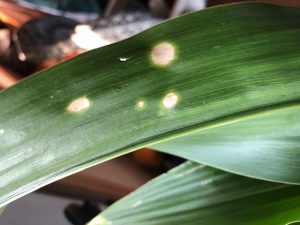Holcus spot in Illinois Corn
The following is posted on behalf of Dr. Nathan Kleczewski, Field Crops Pathologist for Growmark. This content is from the Field Crop Disease Hub webpage Dr. Kleczewski curated.
This week, growers and ag professionals have noticed round tan-colored lesions with red margins and yellow halos on Illinois corn. These symptoms likely were a minor disease called Holcus spot. Holcus spot is a bacterial disease of corn that can occur on young corn and is rarely damaging.
Lesions start off as dark green, water-soaked spots that turn white to tan to grey with time. Lesions are often surrounded by a reddish border and a cream to the white-colored halo. Lesions are range from ⅛ and ½ inch in diameter. Holcus spot typically occurs early in the season after windy, warm, and wet weather (75-85°F). The pathogen resides on residue, where it can be splashed onto the lower parts of the plant. Therefore you may see more of these symptoms on no-till corn. The pathogen enters corn leaves through wounds or natural openings but does not appear to spread from leaf to leaf. Holcus is not the only source of these symptoms on corn. Herbicide drift (e.g. gramoxone) can also result in similar symptoms.

Separating Herbicide drift and Holcus Spot
You can ask yourself the following questions to help you determine if the spots are a result of herbicide drift or Holcus spot:
1) Is the symptomatic corn near a field that recently received a burndown herbicide application? If the answer is yes, then you might suspect herbicide drift.
2) Are the symptoms more severe at the field edge or uniformly distributed throughout the field? If the symptoms are more severe on the outside of the field and gradually decrease as you move towards the center of the field, this may indicate potential herbicide drift.
3) Are plants around the field (ditches, driveways) showing symptoms? If yes, then again, the potential culprit is herbicide drift.
Regardless of the source, corn showing potential herbicide drift injury or Holcus spot is not at risk. Plants will grow out of herbicide drift and Holcus spot is not known to be yield-limiting. Although the lesions may cause concern to some, within-season management is not available nor is it required.





